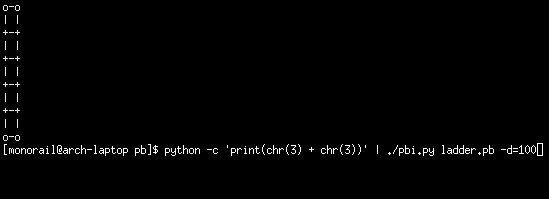두 개의 정수 n 과 m 을 입력하면 길이 n 과 크기 m 의 ASCII 래더를 출력합니다 .
이것은 길이 3과 크기 3의 ASCII 래더입니다.
o---o
| |
| |
| |
+---+
| |
| |
| |
+---+
| |
| |
| |
o---o
길이가 5이고 크기가 1 인 ASCII 래더입니다.
o-o
| |
+-+
| |
+-+
| |
+-+
| |
+-+
| |
o-o
길이 2와 크기 5의 ASCII 래더입니다.
o-----o
| |
| |
| |
| |
| |
+-----+
| |
| |
| |
| |
| |
o-----o
구체적으로 :
길이 ( n )는 사다리가 구성된 사각형의 수를 나타냅니다.
크기 ( m )는 각 사각형의 내부, 즉 "테두리"를 세지 않는 폭과 높이를 나타냅니다.
각 정사각형은 공간으로 채워진 내부 영역으로 구성되어 있으며
-, 위쪽과 아래쪽에|s, 왼쪽과 오른쪽에+s , 그리고 네 모퉁이 에 s로 둘러싸여 있습니다.사각형 사이의 경계는 서로 합쳐 지므로 한 줄에있는 두 줄이
+--...--+하나로 합쳐집니다.전체 사다리의 모서리가 문자로 바뀝니다
o.선택적으로 후행 줄 바꿈을 출력 할 수 있습니다.
사다리의 길이 ( n )는 항상 2 이상 이고 크기 ( m )는 항상 1 이상입니다.
입력은 공백 / 쉼표로 구분 된 문자열, 배열 / 목록 등 또는 두 개의 함수 / 명령 줄 등으로 사용할 수 있습니다. 인수. 가장 편리한 / 골프적인 순서로 인수를 취할 수 있습니다.
이것은 code-golf 이므로 바이트 단위의 가장 짧은 코드가 이깁니다.
팁 : 위의 예는 테스트 사례로도 사용할 수 있습니다.
